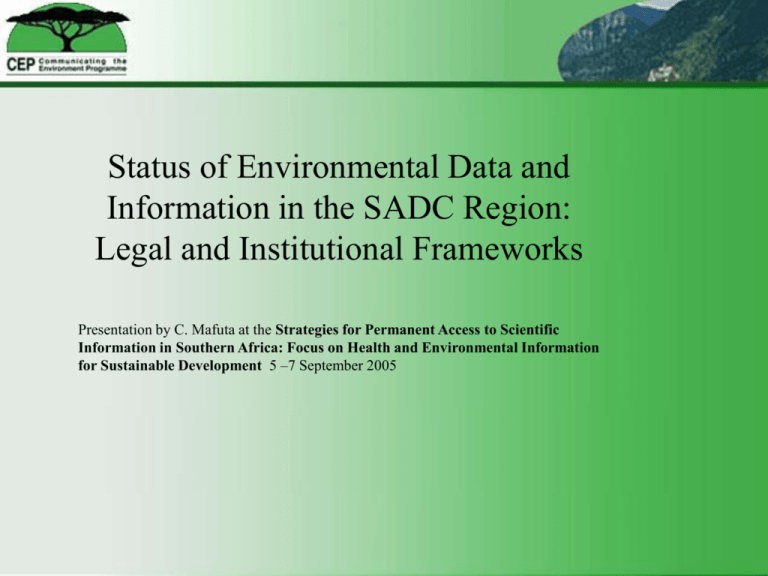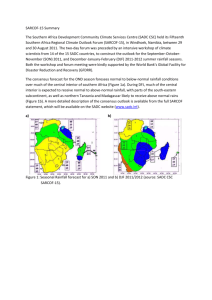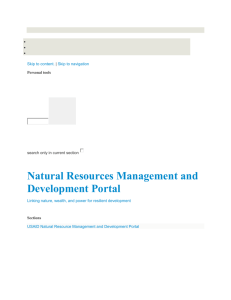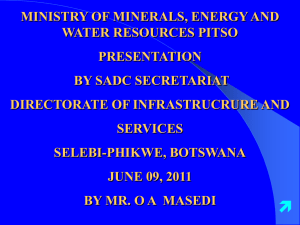Presentation - Nexus Database System
advertisement

Status of Environmental Data and Information in the SADC Region: Legal and Institutional Frameworks Presentation by C. Mafuta at the Strategies for Permanent Access to Scientific Information in Southern Africa: Focus on Health and Environmental Information for Sustainable Development 5 –7 September 2005 Introduction • Geographical scope of the presentation is the Southern African Development Community – Angola, Botswana, the DRC, Lesotho, Madagascar, Malawi, Mauritius, Mozambique, Namibia, South Africa, Swaziland, Tanzania, Zambia and Zimbabwe • Region has a population of around 215 million Introduction • All SADC countries have in place environmental policies which directly or indirectly subscribe to the right to live in a clean and healthy environment, which in turn carries with it the right to be informed about environmental issues, and calls for the development of appropriate information systems • The need for information and reliable data is further emphasized in the region’s key development initiatives, including the MDGs, NEPAD and the RISDP. EIS Developments • The development of southern Africa’s environmental information systems (EIS) can be traced to the late 1980s when the then SADC Environment and Land Management Sector (ELMS) organised a series of meetings and workshops, in collaboration with a number of partners such as UNEP, IUCN, UNITAR and SARDC. • The region’s EIS programme was boosted with the establishment of the training and education subprogramme and the technical and networking subprogramme. EIS Developments • The training and education sub-programme was implemented by the University of Botswana under an initiative called the SADC EIS Training and Education (SETES) initiative • The technical and networking sub-programme was implemented by the then SADC Food Security Technical and Administrative Unit in Harare, through the SADC EIS Technical Unit (SETU) EIS Development • SADC SETU took the lead in pursuing the development of the EIS Network in the region, through partnerships with, amongst others, IUCN ROSA and SARDC IMERSCA • The collaborative effort coordinated by SADC SETU resulted in the development of the region’s initial EIS databases – Bibliographic databases – Contacts databases – Geo-spatial biodiversity meta-database EIS Developments • A number of other EIS initiatives were taken, including the development of the Biodiversity Information System in the SADC region • The Southern African Biodiversity Support Programme (SABSP)’s Regional Biodiversity Information Systems (RBIS) built on the national environmental information systems through Biodiversity Information Centres EIS Developments • The World Network for Exchange of Information (INFOTERRA), considered one of the world’s largest networks for the exchange of environmental information and whose objective is to stimulate and allow the exchange and flow of technical and scientific environmental information between the countries, is key to the development of southern Africa’s EIS World Network for Exchange of Information (INFOTERRA) • INFOTERRA network is coordinated by UNEP and is a 173-country affiliation, including most SADC countries. • The Southern African Sub Regional INFOTERRA Network (SASIN) coordinates activities in southern Africa EIS Developments • Another initiative supportive of the region’s EIS process is the SADC Water Resource Database (WRD), which evolved from the need to estimate the potential of small-water bodies fisheries development • This database integrates information on surface water bodies, watersheds, rivers, fish species distribution and related data, in a Geographic Information System. The WRD has a number of databases, including: – Surface water body database – Watershed database – River database – Aquatic species distribution database EIS Developments • The EIS process in southern Africa also includes the identification, agreement and development of indicators used in trend analysis in state of environment reporting in the SADC region • This regional collaborative initiative is being undertaken by the Communicating the Environment Programme (a partnership of SADC, IUCN ROSA and SARDC IMERCSA), with support from the Department of Environmental Affairs and Tourism of South Africa and UNEP • Under the initiative a core set of indicators for state of environment reporting has been developed, based on internationally accepted criteria for indicators of sustainability, and is being tested for relevance and data availability in the region EIS Developments • A process to collect socio-economic driving forces data and integrate these into a GIS was also undertaken jointly by the HSRC and SARDC as part of efforts to strengthen the region’s EIS EIS Developments • Following the realisation that data resources for environmental management are segmented, tending to be application-specific, originating from different organisations that collect and maintain data for their own particular purposes, and very often designed and operated independently of each other, a comprehensive Africa-wide initiative called the Africa Environment Information Network is being implemented by UNEP through a network of collaborating centres and pilot countries • UNEP’s collaborating centre for southern Africa is SARDC IMERCSA, while the two pilot countries which recently concluded the first phase of the AEIN are Lesotho and Zambia • One of the key outputs of the AEIN is the Africa Environment Outlook EIS, through which a comprehensive electronic database of bibliographic, experts and contacts, statistics, and map information is available on-line Key constraints • Southern Africa suffers from lack of regionally generated statistics, depending largely on international organisations for data and information • In some cases the data and information from such international sources is disputed as it is based on projections and is not ground-truthed • There are many reasons which force the region to depend on data from international sources, including lack of up-todate statistics, lack of comparability of data across countries, and limitations in dissemination mechanisms such as databases, networking and connectivity Key constraints • Commonly raised issues in as far as access to environmental data is concerned are: – data ownership or proprietary; – technical issues; and – institutional issues Data Ownership • Concerns about protection of property intellectual rights result in a wide range of information materials being classified as confidential • Data sharing and access are further hampered by the growing shift towards commercialisation, which puts a monetary value to all sorts of products, including information and data Technical Issues • Government, academic and research institutions across the SADC region, dealing with environmental information, have important environmental datasets and databases. • Most such datasets and databases are available online. • However, most of these databases have little spatial reference information, and the datasets and databases are of varying quality and are scattered and not well networked Institutional Issues • The institutional set-up varies among the different SADC countries. • In the majority of countries statistics are handled by many institutions, so much that it is common to find overlaps and gaps in their work. • For example, in Zimbabwe environmental data can be found mainly in the Ministry of Environment and Tourism, although information and data on driving forces for environmental change tends to be located in the Central Statistics Office. Further still, information and statistics about pollution tends to be located in the Ministry of Health and Child Welfare, while maps and other spatial data tends to be found in the Surveyor General’s office. Institutional Issues • The situation in Lesotho is interesting and unique. • The National Environment Secretariat (NES) coordinates environmental issues in the country and is supported by the Committee on Environmental Data Management (CEDAMA). The committee was established in 1999, has a cross-sectoral membership and is chaired by the Bureau of Statistics. Its functions include production of data access and exchange guidelines, as well as development of sustainability indicators. RISDP and Statistics • SADC, through the RISDP, considers statistics a priority intervention area, which aims to provide relevant, timely, accurate and comparable statistical information for planning, policy formulation, implementation, and monitoring and evaluation of SADC integration activities. • The development of the SADC statistics is guided by the strategy document approved by the SADC Council of Ministers in 1998, which stipulates that SADC statistics is critical in the monitoring and evaluation of the SADC Programme of Action and the regional integration process. RISDP and Statistics • The strategy highlights the following challenges: • inadequate resources allocated to statistics in some Member States; • disparities in capacities among countries; • inadequate statistical capacity at the SADC secretariat to coordinate statistics in the region; • absence of the legal instrument for regional cooperation in the area of statistics; – lack of dissemination mechanisms, including databases and internet connectivity; and – long time lag between collection of data and dissemination of statistics. RISDP and Stats • The strategy document focuses on: – developing a legal framework for regional cooperation in statistics; – harmonisation of statistical information; – collating, processing and disseminating official statistics; – developing indicators for monitoring and evaluating regional integration; and – building capacity for national and regional statistical systems. RISDP and Statistics • RISDP Targets for Statistics – Development of a legal framework, 2004-2006 – Harmonisation of SADC statistics by 2015 – Development of integrated regional statistics database in all priority areas, including poverty, gender, informal sector, HIV and AIDS, by 2015 – Development of indicators for monitoring and evaluation, 20042005 – Enhancement of statistics capacity in SADC by 2015 – Development of economic models and forecasting mechanisms for statistics, 2004-2006 RISDP Targets for Statistics – Establishment of a multi-sectoral forum of users and producers of statistics, 2004 – Enhancement of utilisation of cost-effective ICTs in sharing information in the priority areas, 2015






